My Amazon KDP Advertising Campaign Strategy for Authors: Don’t Run Ads on Your Books Until You Read This!
I’m hoping I’ve caught you at that pivotal moment before you are running your first ad to your book on Amazon, because what I am about to tell you is going to save you SO MUCH MONEY.
When it comes to book marketing, you really can’t do any better than paid ads on Amazon. They are cheap (if you do them right), targeted (if you do them right), and can really help your career and your book sales (again, if you do them right). Amazon ads are not just the best way to advertise Amazon products. They are absolutely the best way to sell more books.
However, here is my bold and somewhat controversial statement: When it comes to advertising your books, Amazon is making money from your lack of knowledge about their KDP advertising platform, and they don’t seem to be that willing to educate you to keep you from overspending. Why would they?!
I believe Amazon actually WANTS you to rush through the advertising setup for your book. When you rush, they make money. They are counting on the fact that you don’t even want to be paying for advertising (or marketing your book) in the first place, and that you are going to try to get through setting up paid advertising as quickly as possible. They are going to point you in the wrong direction at almost every turn, knowing that you are just throwing advertising money at the wall to see what sticks. I think all of this because of the very existence of “automated ads,” which is basically five clicks to a potentially huge amount of overspending.
First off, no one tells indie authors about the “missing piece” of marketing, which is that you should 100% not be paying for advertising unless you have a means of capturing paid readers and making them your subscribers. You do that by placing a link (or a QR code) inside your book to a freebie you will give them in exchange for joining your email list. If you do not have that, please stop what you’re doing and get my free book on this very subject. Amazon will take your money anytime of the day or night, but do not give them that money unless you have this one piece set up. This is how you ultimately win with paid advertising— by using it to build an email list of super fans that will buy all of your books when they come out so you’re not starting over with every launch. Remember: paid advertising should be used to scale a system that is already working, not to put a Band-Aid on poor book sales! This is one instance where throwing money at the problem is not going to work!
So, go and set that email thing up right now. Right this minute! I’m begging you. The book is free, the email services are all free, and the benefit to your career is immeasurable.
Back to paid advertising, because I am hoping you have seen the light, have fixed that problem, and are now back here wanting some paid advertising strategy to help you sell books AND build your list.
Let me break down this user flow for you, so you can see how this whole thing is set up against you (and what to do about it). I’ll do this by starting an ad for my book “How to Market a Book,” because I love being ironic like that. I’m going to take you through this every step of the way, so go ahead and pull up this post in another browser so you can follow along step by step and start an ad on your own book. We’re in this together!
This is my book:
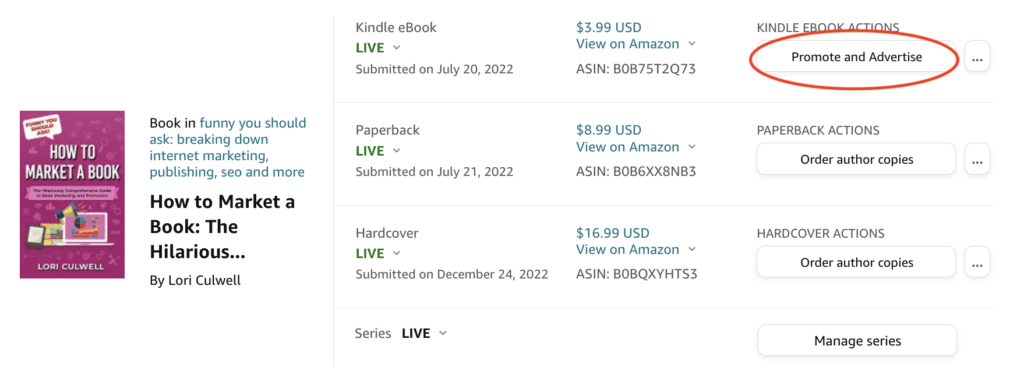
If your book is in KDP (which I’m assuming it is, since you are trying to learn about paid advertising strategies), click on “Promote and Advertise” as indicated above. If you’re advertising the Kindle edition, it’s right there on the side. If you’re advertising the paperback or hardcover, just click on the three little dots, then select “Promote and Advertise.”
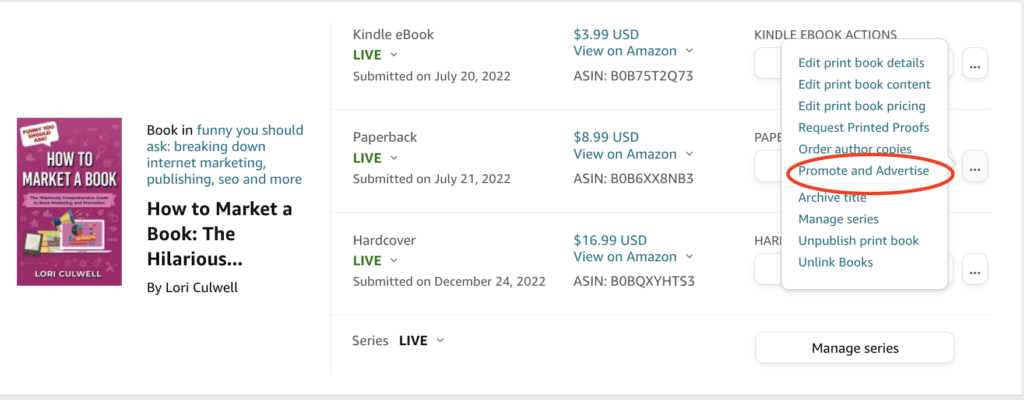
I’m sure this goes without saying, but I’m going to say it anyway: if you’re trying to be thorough, you’ll need to start all of the different ad types for each version of your book (and by that I mean Kindle eBook, Paperback, and Hardcover), because each one of those is a completely different book in Amazon’s eyes and each one has its own sales and BSR (bestseller rank). Many authors choose to just start a set of ads on the Kindle eBook edition just to
Here’s the first screen we see after clicking on “Promote and Advertise” for the eBook. My book is not in KDP Select (the book itself has a whole chapter on why but I won’t bore you with that now), so I’m just picking “Run an Ad Campaign” and selecting the US marketplace. Annoyingly, you will need to open an advertising account for each of the different markets where you want to run ads for your books, because despite being a multi-billion dollar company, Amazon has not figured out how to streamline this interface.
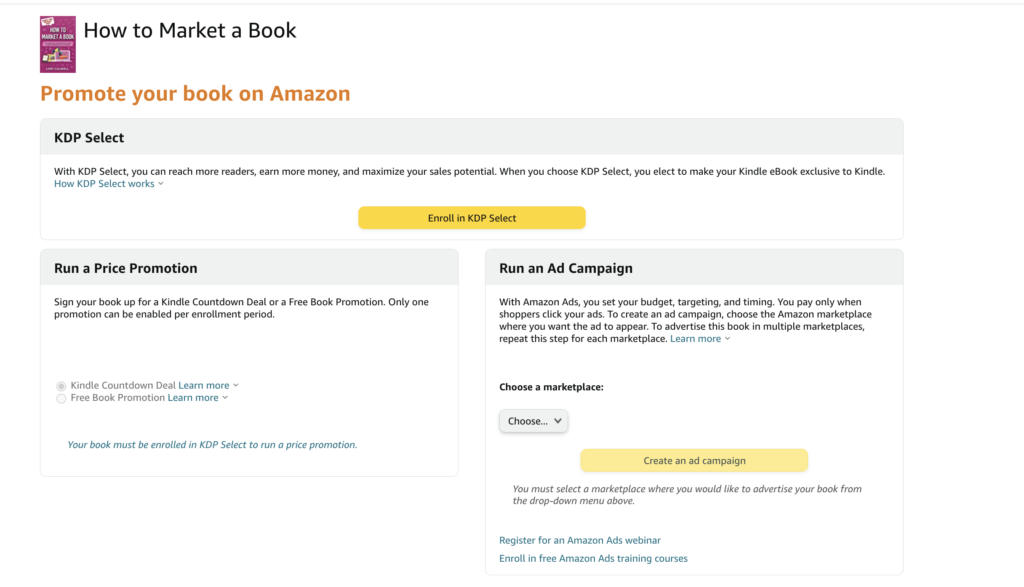
When I choose “.com” and click the yellow “Create an ad campaign” button, I then see this screen:
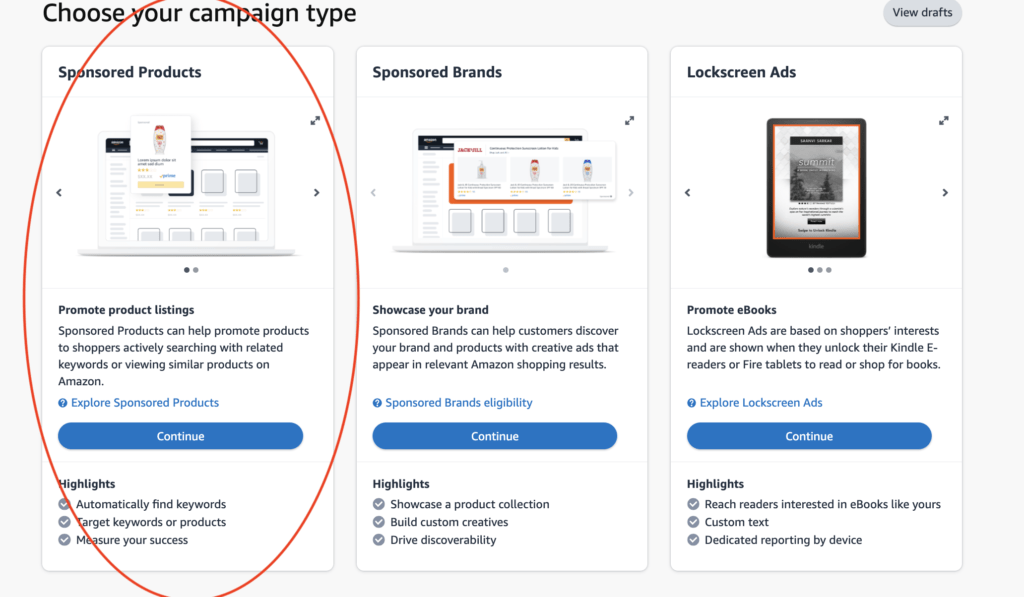
Again, not sure why Amazon makes it so annoyingly difficult for us to spend our money with them, but here we are. You want “Sponsored Products” for the purposes of this example. The other two options are a little more advanced and shouldn’t really be offered to you at this point, since you are just trying to get over the hump of running your first ad. So, go ahead and click the blue “Continue” button under “Sponsored Products.”
Great! Now we are faced with a bunch of other choices. Hang in there! We’re going to get through this!

This box defaults to “custom ad text,” which is weird because that forces you to write ad copy, making it even less likely that you are going to actually launch an ad. I have tested both and have found absolutely no advantage to doing this, so I recommend you just set it to “Standard ad” and move on. If you decide you want to test an ad with some custom copy in the future, you can start a new ad for that.
Name your ad group something that is easy to remember. Yes, this is your very first ad, but if you love paid advertising you’ll be starting a bunch more, so you’ll need to be able to quickly tell them apart.

Next up is the “Products” screen, and if they didn’t select your book already, go ahead and find/ select it.
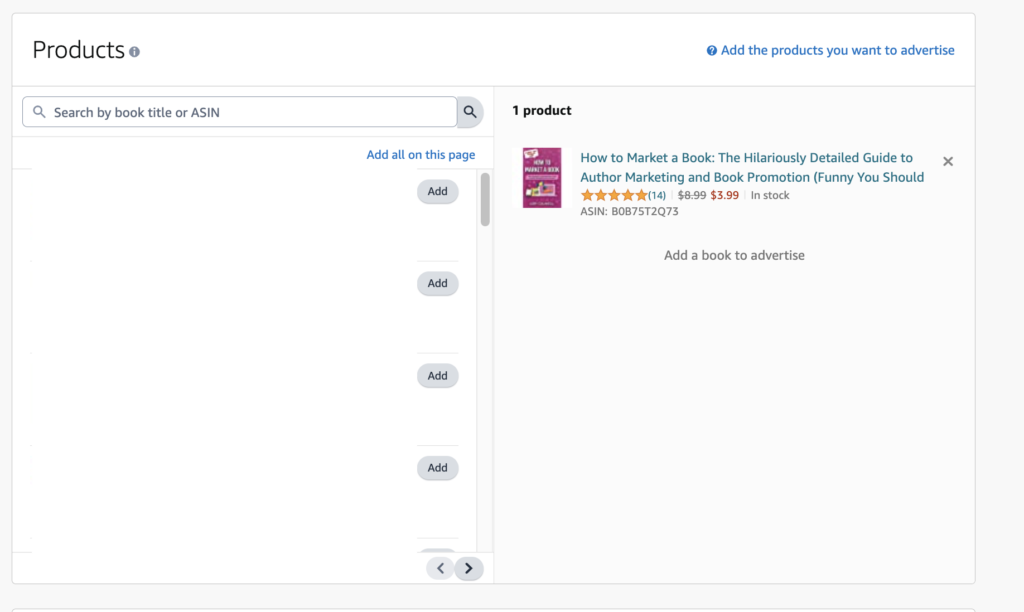
Next, we’re faced with one of the most important choices in the entire paid advertising interface: Automatic vs. Manual targeting. I always warn authors to never ever ever pick automatic targeting, and I’ll tell you why.
I have found the “Automatic Targeting” ad to be absolute worst kind of ad to run, especially if you didn’t do a great job researching your keywords and filling in your seven keyword slots on the back-end of your book when you published it. If you did not do that (or didn’t do a great job of it), that is another thing you can fix that will improve your book’s visibility and sales, and I will cover that in another post.
“Automatic targeting,” in case you don’t know, is when you tell Amazon “You go ahead and pick the keywords/ products to advertise my book against.” It sounds good in theory, but remember, Amazon is trying to make money for itself, not for you. Amazon makes money when someone clicks the ad for your book, whether or not that book is a good fit for them and ends up making a sale. Those are two very different things, and often what will happen is that authors will keep all of the defaults just to get through the setup and end up paying an arm and a leg for Amazon to basically take their book out on a fishing expedition to try to learn more about it.
I have tested this type of ad, and I will honestly say that the only thing an Automated ad is useful for is gathering additional keywords and products you might not have caught in your keyword research (which you can totally do on your own). It can sometimes be interesting to see what Amazon thinks your book is about, but this type of ad is almost always a money loser for authors because it is so broad.
The other problem with the “Automatic Targeting” ads interface is this ridiculous “suggested bid”:

WOW! That is ALOT OF MONEY!
As an author, you are no doubt aware of the fact that you are paid royalties on the sale of every book. My books make about $2 royalties apiece, so I’d be ok paying out 90 cents per click if I could guarantee a sale (plus I have that email signup link in all of my books, so that 90 cents might turn into a life-long customer).
HOWEVER, because we’re in “Mystery Advertising Land” over here where we don’t even know what Amazon is going to show our books against, there is NO WAY we should be offering to pay 75 cents per click for Amazon to push our books out into the metaphorical ether. I’d pay 5 cents a click for this, max, because I am curious where they are going to show my book, but 90 cents?
GET OUT OF TOWN, AMAZON. I am not paying that. Don’t fall for that nonsense because they have that there as the default and because you currently don’t know any better. They’re still might show your ad if you offer to pay 5 or 10 cents a click. They want your money, remember?
Here’s what is going to really get you— the combination of all the defaults. You don’t know what you’re doing, so you go with the open-ended bid (a terrible idea), the Automatic Targeting (again, yikes), and the 75 cent default bid (way too much). That combination is going to end with you overpaying for untargeted traffic, which is going to mean you get a huge bill and don’t sell many (or any) books. If you do sell any books, I would be willing to bet you are still running a deficit because remember, your royalties are only about 20% of what Amazon charges for your book.
This is a deadly trifecta that is not designed to sell books, people. It is designed to make money for Amazon. It’s a trap and I hope you won’t fall into it. If you did fall into it, that’s totally fine– just go and turn that ad off, or at very least lower the bid. All that being said, I hope you have now heeded my warning and will never run an Automatic targeting ad again, but if you do, just PLEASE lower that suggested bid.
ok, rant over. Please start a new ad and pick the “Manual targeting” option, because anything (and I do mean anything) you put in manually is going to be better than paying Amazon to make their best guess.

Both of these types of ads work great, and you can run them both at the same time (you’ll need to start them separately). As with all things Amazon, the more specific you get the better, so make sure you are prepared with a good list of keywords and/ or a list of competitive titles. As with the “Automated Targeting” rant, I will encourage you to never ever take Amazon’s default suggestions. Remember, they are trying to make money for themselves, which they do when they sell advertising clicks, not when you sell books.
Here’s an example of how they are going to try to do that in the “Manual” keyword interface:
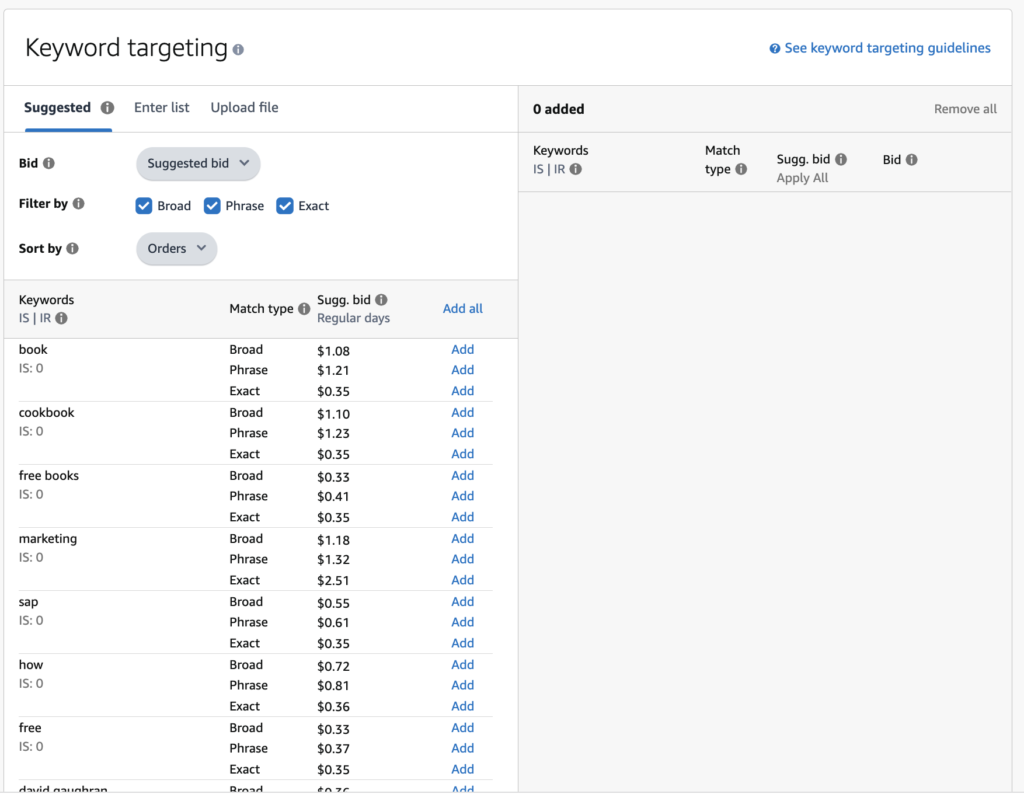
This is hilarious. If I click the “Add All” button and start this ad, Amazon is going to advertise this book against the words “Book,” “Cookbook,” “Free Books,” “marketing,” “sap,” “how” and “free,” and is going to charge me up to $1.21 PER CLICK for that privilege.
Again, no thank you, and please get ahold of yourself, Amazon. I would be happy to come in for a meeting if you’d like some feedback.
The way to best use this particular interface (and to harness the magic of the Amazon suggested search algorithm) is to switch over to the “Enter list” tab. Switch to “custom bid” and set the bid for something really low like 10 cents. Also, uncheck “Broad” for match type, because that gets us back into “Amazon wilding out and advertising your book against random words” territory again.
Your screen will look like this:
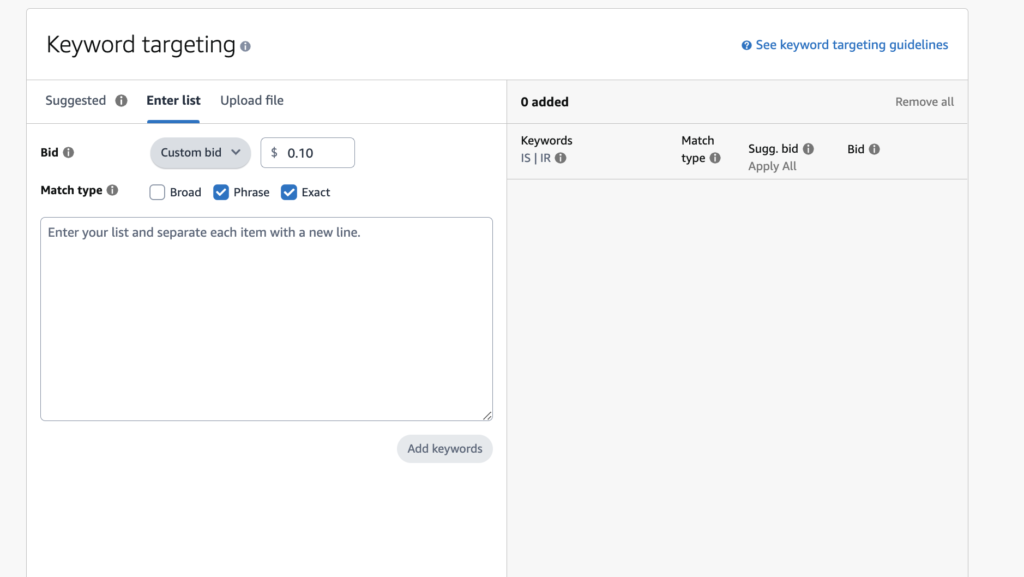
ok, now enter the topic/ genre/ subject of your book, and hold on to your hat! This part is cool.
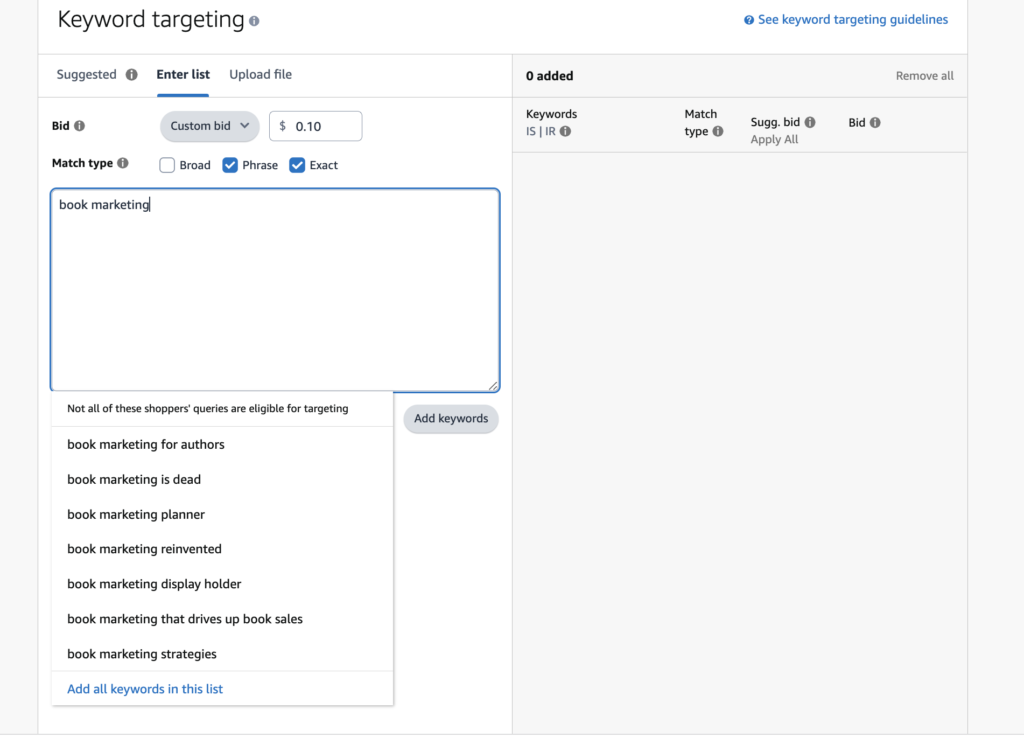
Well, will you look at that?! Amazon is actually being insightful and helpful. Most of these suggestions are what my book is actually about. I will just repeat this type of search with phrases like “how to market a book” and “marketing self-published books” until I have a list of about 50 keywords. When you get the hang of this you can go up to 100 keywords per campaign, but for right now let’s stop at 50 and get this thing launched.
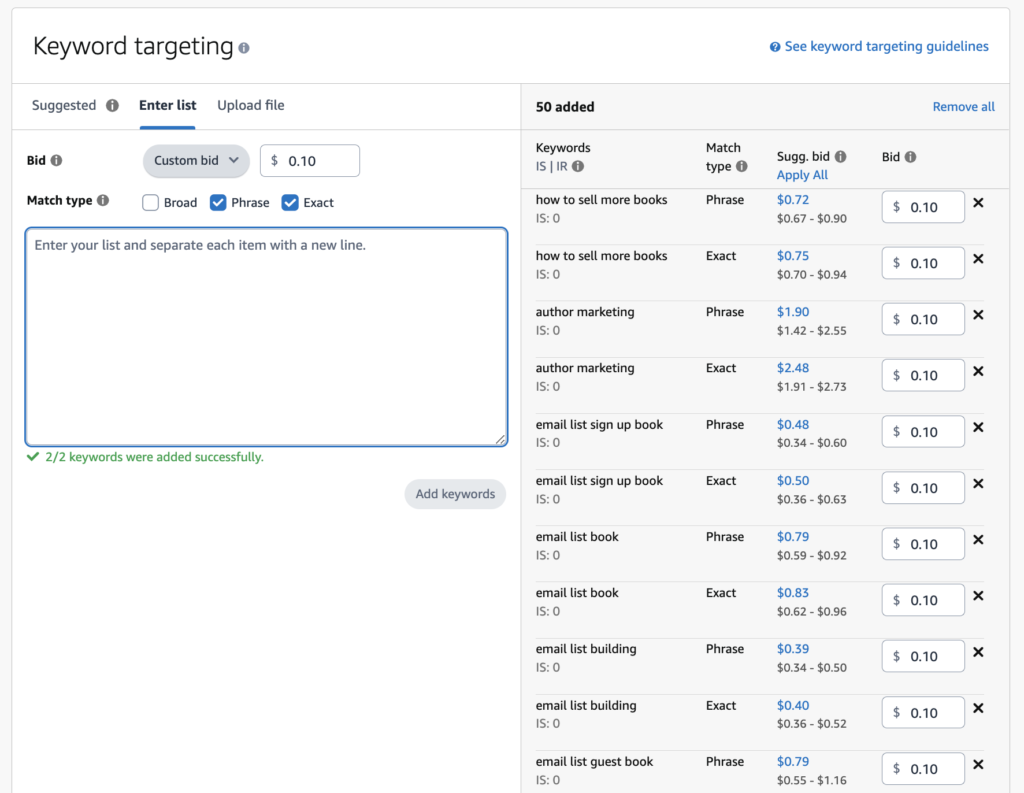
Nice! You should have a similar list that is related to your book’s subject matter or genre. You can use the names of other authors, other books, and anything else you think might be relevant or get someone to buy your book. Also, if you never filled out the seven keyword slots when you published your books, take some of these great keywords and fill those out right this minute!
Next up is “Negative Targeting,” and we’re skipping that because this is our first ad and we don’t have that kind of insight yet. I swear we’re almost done!
“Campaign bidding strategy” is after that, and I recommend that you choose “Dynamic bids, down only” because you never want to give Amazon permission to spend MORE of your money than your default bid. “Down only” is a good option because that way, Amazon can LOWER your bid to see if doing so will still yield a click. If/ when it does, great! You’ll know that for the future.
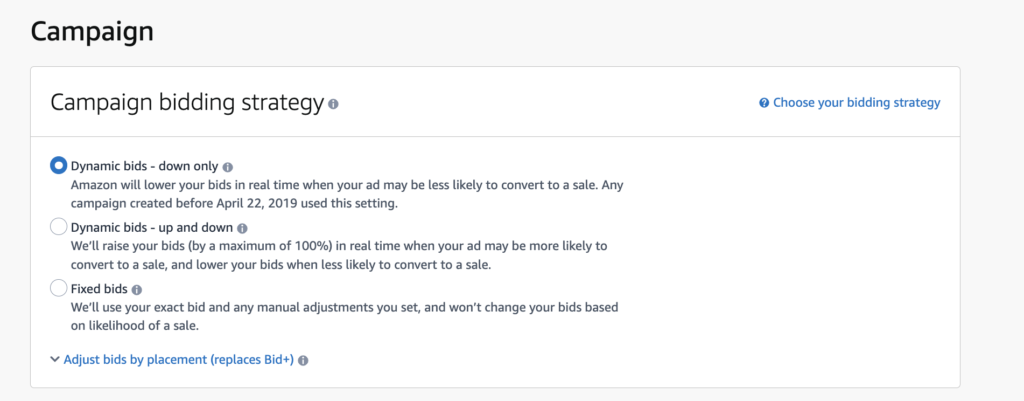
You made it! You’re on the very last choice before you can launch this ad!
I know, that was stupid complicated. I feel your pain.
The very last thing we’re going to do is fill out the “Settings” for the ad. Here’s what mine looks like:
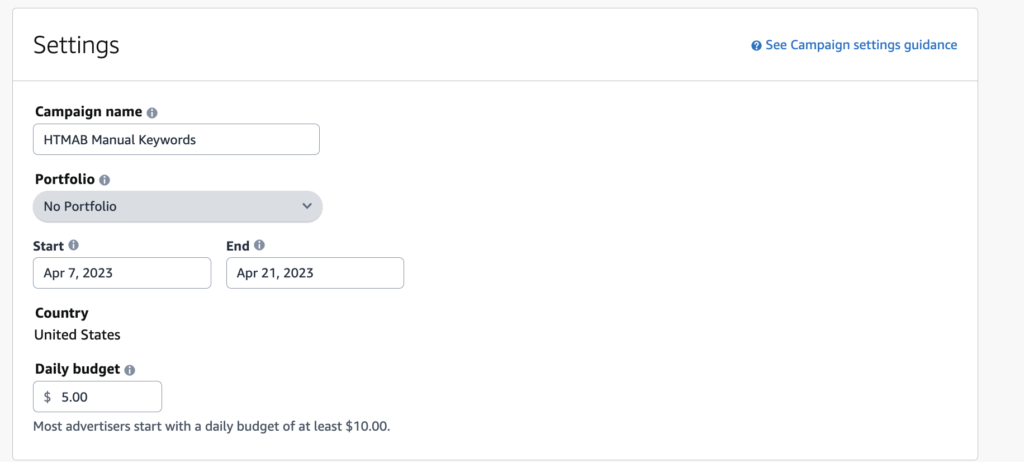
Amazon has now moved this down to the very bottom, which is even more problematic for you because you are likely to be fed up by then and miss this “gotcha” moment. The default for this screen is “No End Date,” but you should actually NEVER start a brand new ad with no end date!! Having no end date is going to make you think you can “set it and forget it,” which you absolutely cannot ever do with paid advertising. “No end date” is just Amazon wanting to stick their hand in your pocket and start taking your money from now on, whether or not your ads are working. They are counting on the fact that you are a right-brained creative ADHD type and you will probably a) forget this ad is running, b) forget to check it regularly, and c) never come back to optimize it. So, whatever they are offering you here is what’s going to happen from now on, and I promise you, you’re not going to like it when you get the bill at the end of the month. Remember, you have to pay Amazon for these ads whether or not they result in book sales.
So— change that date to two weeks from the day you start running the ad. You want to schedule this like everything else in your life that costs money and needs maintenance. You wouldn’t enter into an open-ended, paid agreement with no end date with any other company, so don’t do it here.
The second problem is that you have absolutely no idea what to set your daily budget for, and Amazon’s certainly not going to give you any guidance that might discourage you from getting in over your head. They’ll let you set that sucker to $100 a day and spend every penny! They do not care if you sell no books and end up cash flow negative. They made money, so who cares about you?
I advise people to just set this for $5- $10 dollars per day at the beginning and check it every single day. You will have ample (just, so many!) opportunities to raise your daily budget, so start small and manageable and scale up as you gain more knowledge. There is no need to “go big or go home” at this moment in your career.
Shockingly, YOU ARE NOW DONE with your first ad! Hit that beautiful blue “Launch campaign” button at the bottom.
This button right here!! I made the screenshot huge so we could celebrate this moment together.
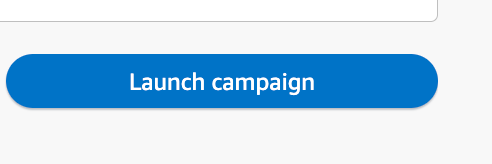
As if you haven’t been through enough, this is actually not the end of this Amazon Advertising nonsense. What happens next is that your ad is “submitted” to some kind of internal Amazon KDP advertising bot for “approval.”

This is rather ambiguous and definitely unsatisfying, but we’ll take it. We’re done for now!
Later, we will receive an email that our ads are running (if they were “approved”). The only reasons why your ad would not be approved is if your book wasn’t actually eligible for advertising (like, it has swear words or objectionable content on the cover or in the subject matter) or if you wrote some custom copy they didn’t like (which you didn’t do because you followed this example and chose a “standard” ad.
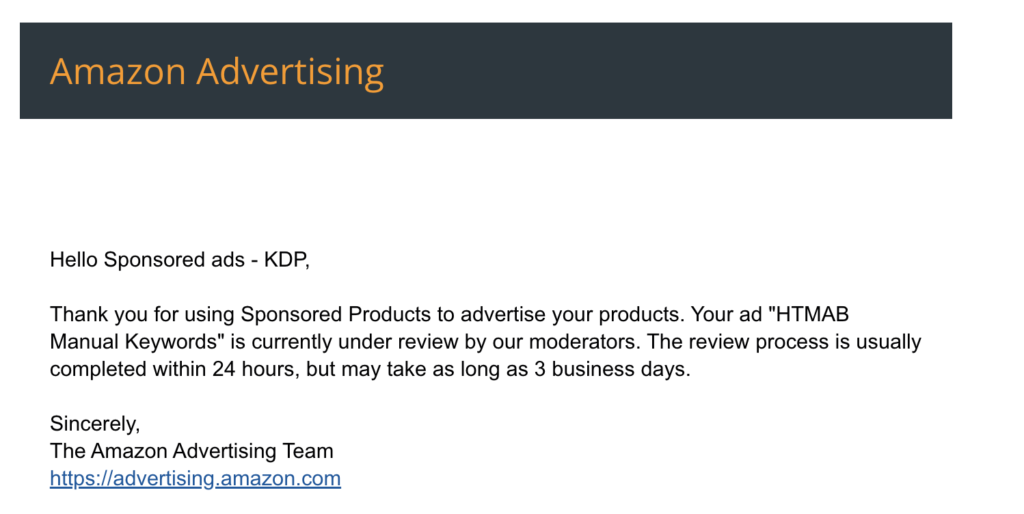
Thanks for that.
OK, I hope you have enjoyed this (probably unnecessarily) deep dive into starting your first Amazon Advertising campaign for KDP. Our takeaways here was that this was stupidly overcomplicated and Amazon is going to take every chance they can to overcharge you, but I hope that I have saved you some frustration and some wasted money.
If you’re interested in following the continued status of how this ad is doing, you can find that post right here!
